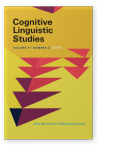Vol. 11:2 (2024) ► pp.371–402
What can the taxonomy of predicative possession in Malwai Punjabi tell us?
A cognitive linguistics approach
The study aims to examine the syntactic and semantic behaviors of predicative possession (i.e., have-possessive constructions) in Malwai Punjabi, an underdocumented dialect within the Indo-Aryan language family. Data was collected from longitudinal online interviews with native speakers as consultants, with audio recordings for transcribed target sentences. The result revealed that all the alienable possession, either permanent/temporary or abstract/concrete, could be marked by the postposition koḷ ‘near/with’, whereas inalienable possession, such as whole-part relation and kinship, could not be encoded using koḷ. The prototypicality model and schema-based metaphors explained why koḷ was widely used to express alienable possession in Malwai Punjabi. The analysis of companion and proximity schemata also justified the extended semantics of predicative possession, suggesting a metaphorical mapping of accompaniment and location onto possession. From a typological angle, the case study can not only provide further evidence for the existence of split possession but also contribute to a cognitive understanding of predicative possession in relation to other languages.
Article outline
- 1.Introduction
- 2.Background of Malwai Punjabi
- 3.Literature review
- 3.1Previous studies on predicative possession
- 3.2Theoretical framework
- 4.Methodology
- 4.1Subjects
- 4.2Design
- 4.3Procedure
- 4.4Transcription and coding
- 5.The distribution of predicative possessive constructions in Malwai Punjabi
- 5.1Five possessive notions
- 5.1.1Physical possession
- 5.1.2Temporary possession
- 5.1.3Permanent possession
- 5.1.4Inalienable possession
- 5.1.5Abstract possession
- 5.1.6Inanimate inalienable possession
- 5.1.7Inanimate alienable possession
- 5.2
Aikhenvald (2013)’s three possessive categories
- 5.2.1Ownership (of property)
- 5.2.2Whole–part relations
- 5.2.3Kinship relations
- 5.1Five possessive notions
- 6.Discussion
- 6.1Prototypical possessive pattern
- 6.2Schemata of possession
- 6.2.1 possessor is accompanee, possessum is companion
- 6.2.2 transferable possession is spatial proximity (location)
- 6.3Typological implication
- 7.Concluding remarks
- Acknowledgements
- Notes
- Author queries
-
References
